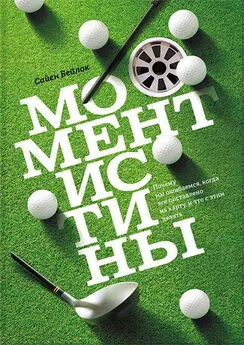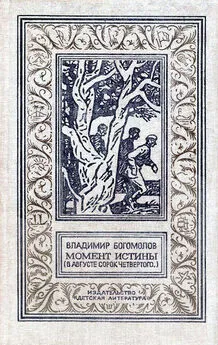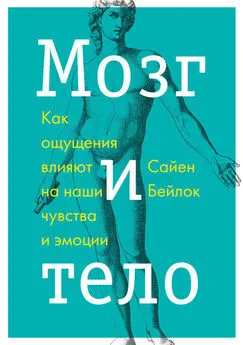Сайен Бейлок - Момент истины. Почему мы ошибаемся, когда все поставлено на карту, и что с этим делать?
- Название:Момент истины. Почему мы ошибаемся, когда все поставлено на карту, и что с этим делать?
- Автор:
- Жанр:
- Издательство:Манн, Иванов и Фербер
- Год:2015
- Город:Москва
- ISBN:978-5-00057-724-0
- Рейтинг:
- Избранное:Добавить в избранное
-
Отзывы:
-
Ваша оценка:
Сайен Бейлок - Момент истины. Почему мы ошибаемся, когда все поставлено на карту, и что с этим делать? краткое содержание
Момент истины. Почему мы ошибаемся, когда все поставлено на карту, и что с этим делать? - читать онлайн бесплатно полную версию (весь текст целиком)
Интервал:
Закладка:
77.Murphy M. C., Steele C. M., Gross J. J. Signaling threat: how situational cues affect women in math, science, and engineering settings // Psychological Science, 2007. Vol. 18. Pp. 879–885.
78.Steele C. M. A threat in the air: How stereotypes shape intellectual identity and performance // American Psychologist, 1997. Vol. 6. Pp. 613–629.
79.Tyre P. The Trouble with Boys: A Surprising Report Card on Our Sons, Their Problems at School, and What Parents and Educators Must Do. New York: Three Rivers Press, 2008.
80.College Board, Summary Reports: 2007: National Report // http://www.collegeboard.com/.
Глава 5
81.Hembree R. The nature, effects, and relief of mathematics anxiety // Journal for Research in Mathematics Education, 1990. Vol. 21. Pp. 33–46. См. также: Beilock S. L., Gunderson L. A., Ramirez G., Levine S. C. Female teachers’ math anxiety affects girls’ math achievement // Proceedings of the National Academy of Sciences, USA, 2010. Vol. 107. Pp. 1860–1863.
82.Alexander L., Martray C. The development of an abbreviated version of the Mathematics Anxiety Rating Scale // Measurement and Evaluation in Counseling and Development, 1989. Vol. 22. Pp. 143–150. Перепечатано с разрешения.
83.Foundations for Success: The Final Report of the National Mathematics Advisory Panel, 2008 // http://www2.ed.gov/about/bdscomm/list/mathpanel/report/final-report.pdf.
84.Ashcraft M. H., Kirk E. P. The relationships among working memory, math anxiety, and performance // Journal of Experimental Psychology: General, 2001. Vol. 130. Pp. 224–237.
85.Steele C. M., Aronson J. Stereotype threat and the intellectual test performance of African-Americans // Journal of Personality and Social Psychology, 1995. Vol. 69. Pp. 797–811.
86.Aronson J. et al. When white men can’t do math: Necessary and sufficient factors in stereotype threat // Journal of Experimental Social Psychology, 1999. Vol. 35. Pp. 29–46.
87.Smith E. E., Jonides J. Storage and executive processes in the frontal lobes // Science, 1999. Vol. 283. Pp. 1657–1661.
88.Rothmayr C. et al. Dissociation of neural correlates of verbal and non-verbal visual working memory with different delays // Behavioral and Brain Functions, 2007. Vol. 3. P. 56. Воспроизведено с разрешения.
89.Beilock S. L., Rydell R. J., McConnell A. R. Stereotype threat and working memory: Mechanisms, alleviation, and spill over // Journal of Experimental Psychology: General, 2007. Vol. 136. Pp. 256–276.
90.DeCaro M. S., Rotar K. E., Kendra M. S., Beilock S. L. Diagnosing and alleviating the impact of performance pressure on mathematical problem solving // Quarterly Journal of Experimental Psychology: Human Experimental Psychology, 2010 // https://hpl.uchicago.edu/sites/hpl.uchicago.edu/files/uploads/QJEP_2010.pdf.
91.Wang J. et al. Perfusion functional MRI reveals cerebral blood flow pattern under psychological stress // PNAS, 2005. Vol. 102. Pp. 17804–17809.
92.Beilock S. L., Carr T. H. When high-powered people fail: Working memory and ‘choking under pressure’ in math // Psychological Science, 2005. Vol. 16. Pp. 101–105.
93.Gimmig D., Huguet P., Caverni J., Cury F. Choking under pressure and working memory capacity: When performance pressure reduces fluid intelligence // Psychonomic Bulletin & Review, 2005. Vol. 13. Pp. 1005–1010.
94.Raven J. C., Raven J. E., Court J. H. Progressive Matrices. Oxford: Oxford Psychologists Press, 1998. См. также: http://psycabi.net/testy/717-test-ravena-progressivnye-matritsy-raven-progressiv-matrices-metodiki-dlya-diagnostiki-intellekta-vzroslykh.
95.Hayes S., Hirsh C., Mathews A. Restriction of working memory capacity during worry // Journal of Abnormal Psychology, 2008. Vol. 17. Pp. 712–717.
96.Dutton D. G., Aron A. Some evidence for heightened sexual attraction under conditions of high anxiety // Journal of Personality and Social Psychology, 1974. Vol. 30. Pp. 510–517.
97.Mattarella-Micke A. et al. Individual differences in math testing performance: Converging evidence from physiology and behavior. Постер представлен на Ежегодной конференции Ассоциации психологической науки, Чикаго, май 2008 г.
98.http://www.wonderlic.com/.
99.http://sports.espn.go.com/espn/page2/story?page=wonderlic/090218.
100.Getting inside their heads // Chicago Tribune, 2008. February 20.
101.Wondering about the Wonderlic? // USA Today, 2006. February 28.
102.College Board, The Sixth Annual AP Report to the Nation // http://www.collegeboard.com/apreport.
Глава 6
103.The Nation’s Report Card, National Assessment of Educational Progress // http://nces.ed.gov/nationsreportcard/.
104.Liston C., McEwen B. S., Casey B. J. Psychosocial stress reversibly disrupts prefrontal processing and attentional control // Proceedings of the National Academy of Sciences, USA, 2009. Vol. 106. Pp. 912–917.
105.Liston C., McEwen B. S., Casey B. J. Psychosocial stress reversibly disrupts prefrontal processing and attentional control // Proceedings of the National Academy of Sciences, USA, 2009. Vol. 106. Pp. 912–917. Воспроизведено с разрешения.
106.Cohen G. L., Garcia J., Apfel N., Master A. Reducing the racial achievement gap: A social-psychological intervention // Science, 2006. Vol. 313. Pp. 1307–1310.
107.Cohen G. L. et al. Recursive processes in self-affirmation: Intervening to close the minority achievement gap // Science, 2009. Vol. 324. Pp. 400–403.
108.Дополнительно см.: Beilock S. L. Math performance in stressful situations // Current Directions in Psychological Science, 2008. Vol. 17. Pp. 339–343.
109.Ramirez G., Beilock S. L. The ‘writing cure’ as a solution to choking under pressure in math. Работа представлена на Ежегодной конференции Общества психономики, Чикаго, ноябрь 2008 г.
110.Pennebaker J. W. Writing about emotional experiences as a therapeutic process // Psychological Science, 1997. Vol. 8. Pp. 162–166. См. также: Pennebaker J. W. Writing to Heal: A Guided Journal for Recovering from Trauma and Emotional Upheaval. Oakland: New Harbinger, 2004.
111.Depue B. E., Curran T., Banich M. T. Prefrontal regions orchestrate suppression of emotional memories via a two-phase process // Science, 2009. Vol. 317. Pp. 215–219. См. также обсуждение статьи: Holmes E. A., Moulds M. L., Kavanagh D. Memory Suppression in PTSD Treatment? // Science, 2009. Vol. 318. Pp. 1722. Здесь речь о том, что утверждение, будто подавление — эффективная стратегия для навязчивых состояний, противоречит имеющимся данным.
112.Klein K., Boals A. Expressive writing can increase working memory capacity // Journal of Experimental Psychology: General, 2001. Vol. 130. Pp. 520–533.
113.Lieberman M. D. et al. Putting feelings into words: affect labeling disrupts amygdala activity in response to affective stimuli // Psychological Science, 2007. Vol. 18. Pp. 421–428.
114.Lutz A., Slagter H. A., Dunne J. D., Davidson R. J. Attention regulation and monitoring in meditation // Trends in Cognitive Science, 2008. Vol. 12. Pp. 163–169. См. также: What the Beatles gave science // Newsweek, 2007. November 19.
115.Pagnoni G. et al. ‘Thinking about not-thinking’: Neural correlates of conceptual processing during Zen meditation // PLoS ONE, 2008. P. e3083.
116.Slagter H. A. et al. Mental training affects distribution of limited brain resources // PLoS Biol. 2007. Vol. 5. P. e138.
117.Beilock S. L., Todd S., Lyons I., Lleras A. Meditating the pressure away (в работе).
118.Wall Street bosses, Tiger Woods meditate to focus, stay calm // http://www.bloomberg.com/apps/news?pid=20601088&sid=aR2aP.X_Bflw&refer=muse#.
119.Just say om // Time, 2003. August 4 // http://www.time.com/time/magazine/article/0,9171,1005349,00.html.
120.Shih M., Pittinsky T. L., Ambady N. Stereotype susceptibility: Identity salience and shifts in quantitative performance // Psychological Science, 1999. Vol. 10. Pp. 80–83.
121.Gresky D. M., Eyck L. L. T., Lord C. G., McIntyre R. B. Effects of salient multiple identities on women’s performance under mathematical stereotypes // Sex Roles, 2005. Vol. 53. Pp. 703–716.
122.Дополнительно см.: http://reducingstereotypethreat.org/reduce.html#deemphasizing. См. также: Danaher K., Crandall C. S. Stereotype threat in applied settings re-examined // Journal of Applied Social Psychology, 2008. Vol. 38. Pp. 1639–1655.
123.Marx D. M., Ko S. J., Friedman R. A. The ‘Obama Effect’: How a salient role model reduces race-based performance differences // Journal of Experimental Social Psychology, 2009. Vol. 45. Pp. 953–956. Обратите внимание, что отсутствие существенных различий в результатах между белыми и темнокожими участниками эксперимента после речи Обамы на Конгрессе Демократической партии было зафиксировано только у тех, кто действительно слушал его речь. См. также: Aronson J., Jannone S., McGlone M., Johnson-Campbell T. The Obama effect: An experimental test // Journal of Experimental Social Psychology, 2009. Vol. 45. Pp. 957–960 (в этой статье речь об ограничениях работы Маркса и коллег).
124.Dasgupta N., Asgari S. Seeing is believing: Exposure to counter stereotypic women leaders and its effect on the malleability of automatic gender stereotyping // Journal of Experimental Social Psychology, 2004. Vol. 40. Pp. 642–658. Обратите внимание, что мнения женщин изучались в ходе Implicit Association Test (IAT), который рассчитан на определение того, как люди подсознательно оценивают качества женщин как лидеров по сравнению с ролью ведомых.
125.Carrell S. E., Page M. E., West J. E. Sex and science: How professor gender perpetuates the gender gap // National Bureau of Economic Research Working Paper, 14959, May 2009 // http://www.nber.org/papers/w14959.
126.Johns M., Schmader T., Martens A. Knowing is half the battle: Teaching stereotype threat as a means of improving women’s math performance // Psychological Science, 2005. Vol. 16. Pp. 175–179. Этот эксперимент подразумевает общее информирование женщин о стереотипах по поводу их способностей к математике, а также подчеркивание того, что данные стереотипы именно к ним не относятся.
Читать дальшеИнтервал:
Закладка:










